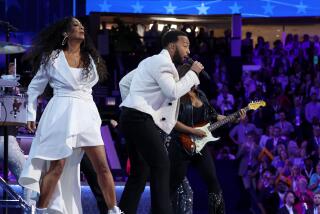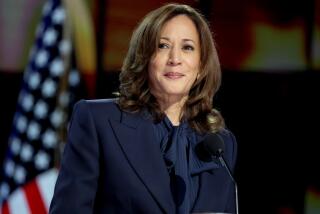Some Things Have Changed Since ’60 Convention--Then There’s the Traffic
- Share via
The year was 1960 and the Democrats about to descend on Los Angeles for the only national political convention in the city’s history received this warning from the Reporter magazine:
“There is no historical precedent to show how the size and shape of a city can affect convention results--but then, no political party ever held a convention in a place like this.”
The city has a freeway system, the magazine went on to say, “whose newest links become inadequate before they can be completed” and a mass transit system that is “about as unpredictable as space travel.”
Some things never change.
On the other hand, when the Democrats return in 2000, they probably should not expect to find “golden girls,” the hostesses who greeted the 1960 conventioneers and acted as guides.
It has been so long since Los Angeles hosted a major political convention that contemporary Clipper fans--a small, beleaguered minority, like liberal Democrats or moderate Republicans--can be forgiven their confusion over finding a portrait of John F. Kennedy hanging near the Sports Arena hot dog stand. For the record, JFK won the Democratic presidential nomination there.
If California is so politically important, why is it that Los Angeles has had fewer national political conventions than say, Miami Beach? San Francisco hosted the 1956 and 1964 Republican conventions and the 1920 and 1984 Democratic conventions. San Diego hosted the 1996 GOP convention.
(It’s not quite the same, but Los Angeles actually hosted two Democratic conventions in 1960. The other was a reenactment of the 1924 gathering in which 3,150 film extras playing the role of delegates crowded into the Shrine Auditorium to shoot scenes for the film “Sunrise at Campobello,” the biography of Franklin D. Roosevelt.)
Maybe it has something to do with the Sports Arena, but when it comes to conventions, Los Angeles’ losing streak is a lot like the Clippers’.
‘Before the Era of Suspicion’
It certainly isn’t because the town didn’t have fun the last time. Those who attended the 1960 extravaganza recall JFK climbing down a fire escape and leaping over a fence to elude reporters, and vice presidential nominee Lyndon B. Johnson marching to the rostrum accompanied by Lady Bird and Lucy but without Lynda Bird, who was 16 and spending the day at Disneyland.
Walter Karabian, the 21-year-old USC student body president in 1960, recalled being put in charge of recruiting student drivers to chauffeur VIPs in new Chevys “with fins.” The cars, sporting special license plates that said “Democratic National Convention, 1960” and displaying the figure of a donkey, were loaned by General Motors.
“This was before the era of suspicion,” said Karabian, a former state legislator.
Rep. Howard L. Berman, a 19-year-old UCLA student at the convention, recalled gathering signatures on petitions to draft Los Angeles-born Adlai E. Stevenson for the Democratic presidential nomination. “I remember how naive I was about the nomination process at the time,” he said. During the convention, he watched as the petitions were rolled into a huge ball and tossed around the arena like beach balls at basketball games.
And former City Councilwoman Rosalind Wyman, who helped bring the 1960 convention to Los Angeles, recalled how surprised she was to see Stevenson supporters packing the gallery.
“In those days, you could counterfeit tickets pretty easy,” chuckled political consultant Joseph Cerrell, a 25-year-old member of the 1960 host committee.
Los Angeles pledged $350,000 in cash, but won the convention only after a heated four-hour debate in which the Pennsylvania governor complained that the 1920 Democratic convention in San Francisco had left the party in debt for years because of the high cost of hauling delegates all the way to the West Coast. One Los Angeles opponent waved a photograph of the smog-shrouded city.
Even before the convention began, a dispute broke out over how many tickets would be made available to the host committee, prompting threats by Democratic Party officials to move the convention elsewhere.
The dispute was settled, and the convention came to town at a time when City Hall was the tallest building, Baxter Ward was a TV newscaster and smog forecasts were published on the front page of The Times every day.
Transportation was a problem. As Lt. Gov. Wilson W. Wyatt of Kentucky put it: “Anybody you want to see is an hour and six bucks by cab away.”
About 4,500 delegates and alternates gathered in the new $7-million, flag-bedecked Sports Arena, where smoking was not only allowed, but also virtually mandatory. In fact, according to one news account, one of the “chief complaints at a sick bay set up off the convention floor” was “smarting eyes caused by smoke in the arena and headaches.”
Martin Luther King Led Demonstration
About 5,000 newspeople covered the convention; the 2000 edition is expected to draw 15,000 journalists from around the world.
“Vigorous attacks on the Eisenhower-Nixon administration, bearing down hard on foreign policy blunders which have enabled Khrushchev to boldly aim his intercontinental missiles at America . . . are expected to form the grist for the five-day Democratic gathering,” The Times reported in anticipation.
A civil rights demonstration led by a rising young national force named Martin Luther King Jr. was staged at the nearby Shrine Auditorium.
Only 600 of the Democrats’ delegates were women, but their convention had a queen to reign over it--dark-haired, blue-eyed Sandra Marakas, 18, of Reseda. Sandra, who the press carefully reported measured 36-21-36, was chosen from a field of 20 contestants gathered at the Ambassador Hotel pool.
Hollywood celebrities drew a lot of attention at the convention, as they surely will at next year’s gathering.
“There was enthusiastic applause for Kennedy’s brother-in-law, Peter Lawford, and for Frank Sinatra, also an ardent Kennedy fan,” The Times reported.
There also were celebrated no-shows: “Harry Truman’s $123-a-day hotel suite remained empty yesterday but still reserved for him,” The Times wrote. “He’ll be billed for the suite regardless of whether he shows up, a hotel spokesman said.” In fact, Truman boycotted the convention, which he judged a “prearranged affair.”
Meanwhile, for those who did turn up, businesses took out newspaper ads pitching such products as a gold charm of a donkey and, from Baskin Robbins, “candi-date ice cream” featuring butter chip candy (“to butter up the voters”) and dates in rich vanilla ice cream.
There were the predictable gibes in the press: “For those delegates who wondered what happened to the local mountains--they’re still there. You just couldn’t see them [through] the smog yesterday.”
Times political editor Kyle Palmer complained that there were “altogether too many gadgets around--too many intricate telephone devices, too many walkie-talkies, too many microphones, too many television screens.” What the legendary local fixer would have made of cellular phones, satellite dishes and cable news networks is anybody’s guess.
The nerve center for Kennedy’s political operation was a bank of suites on the eighth floor of the Biltmore Hotel, but the 43-year-old Massachusetts senator watched the balloting on TV from his Rossmore Avenue hideaway in Hancock Park.
Kennedy delivered his acceptance speech before 50,000 supporters at the Coliseum, where a plaque today commemorates the event.
At the nearby Sports Arena, another portrait can be found. It is of Richard Nixon, who as vice president dedicated the facility in 1959. A year later, he lost the presidential race to Kennedy.
More to Read
Get the L.A. Times Politics newsletter
Deeply reported insights into legislation, politics and policy from Sacramento, Washington and beyond. In your inbox three times per week.
You may occasionally receive promotional content from the Los Angeles Times.











